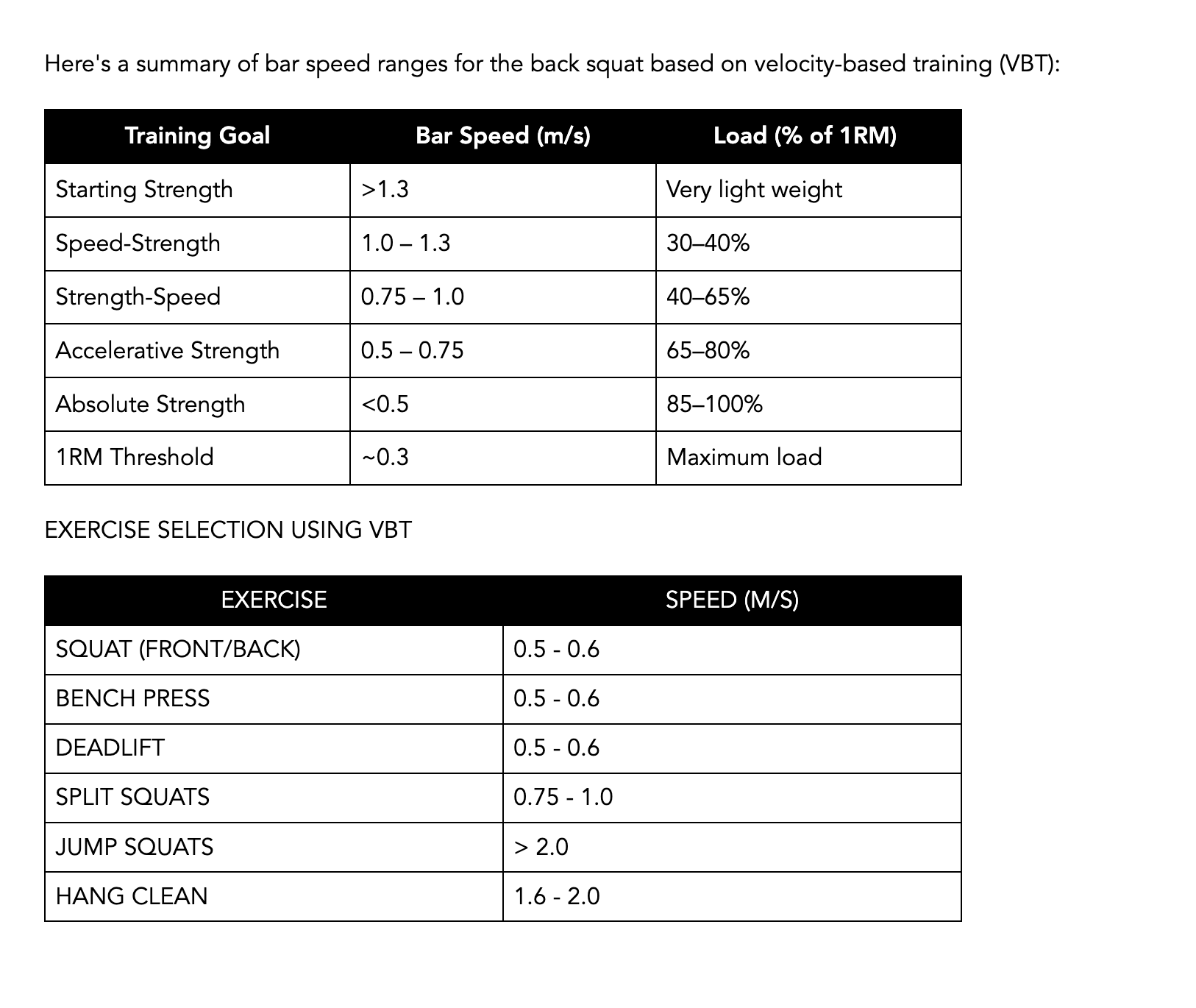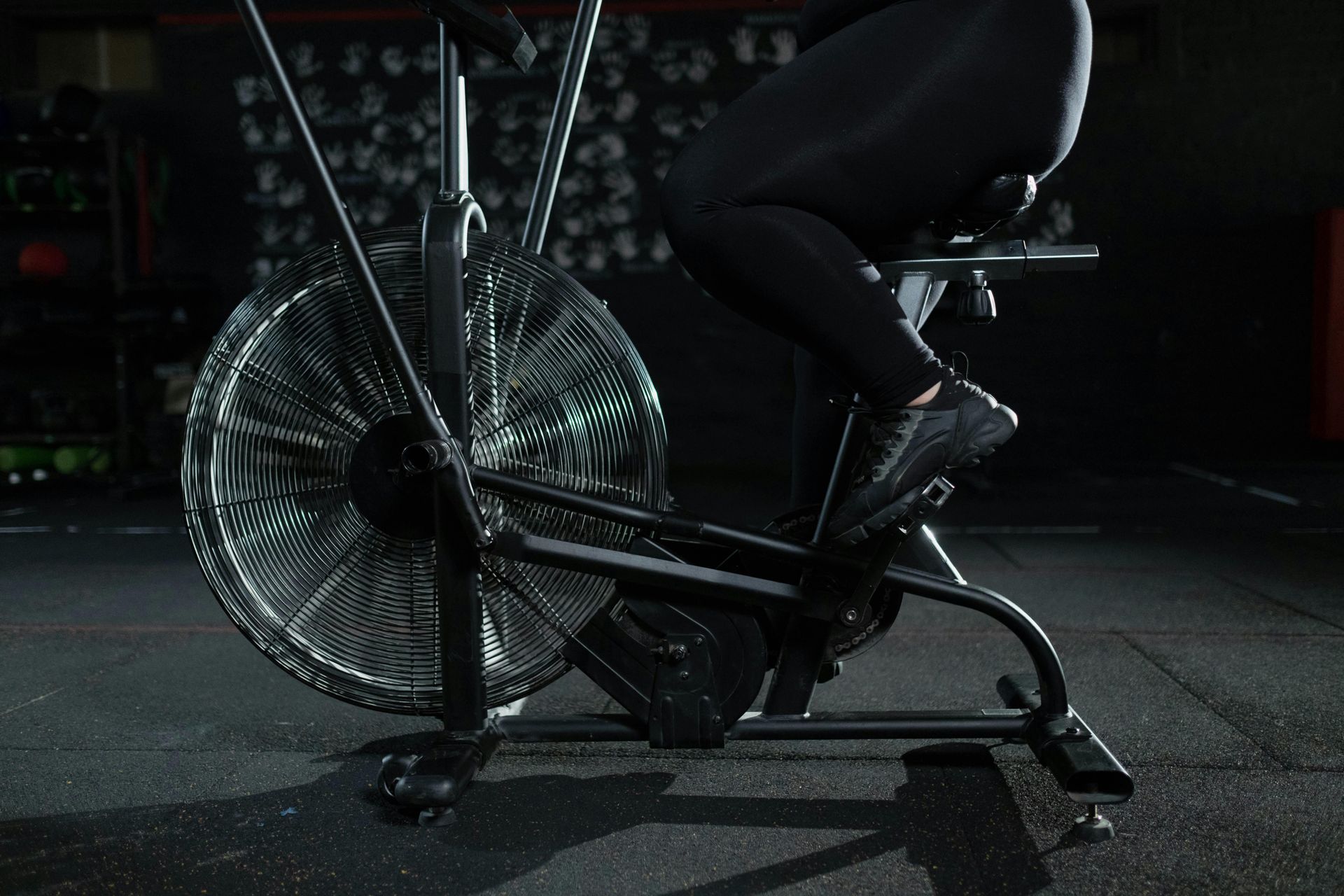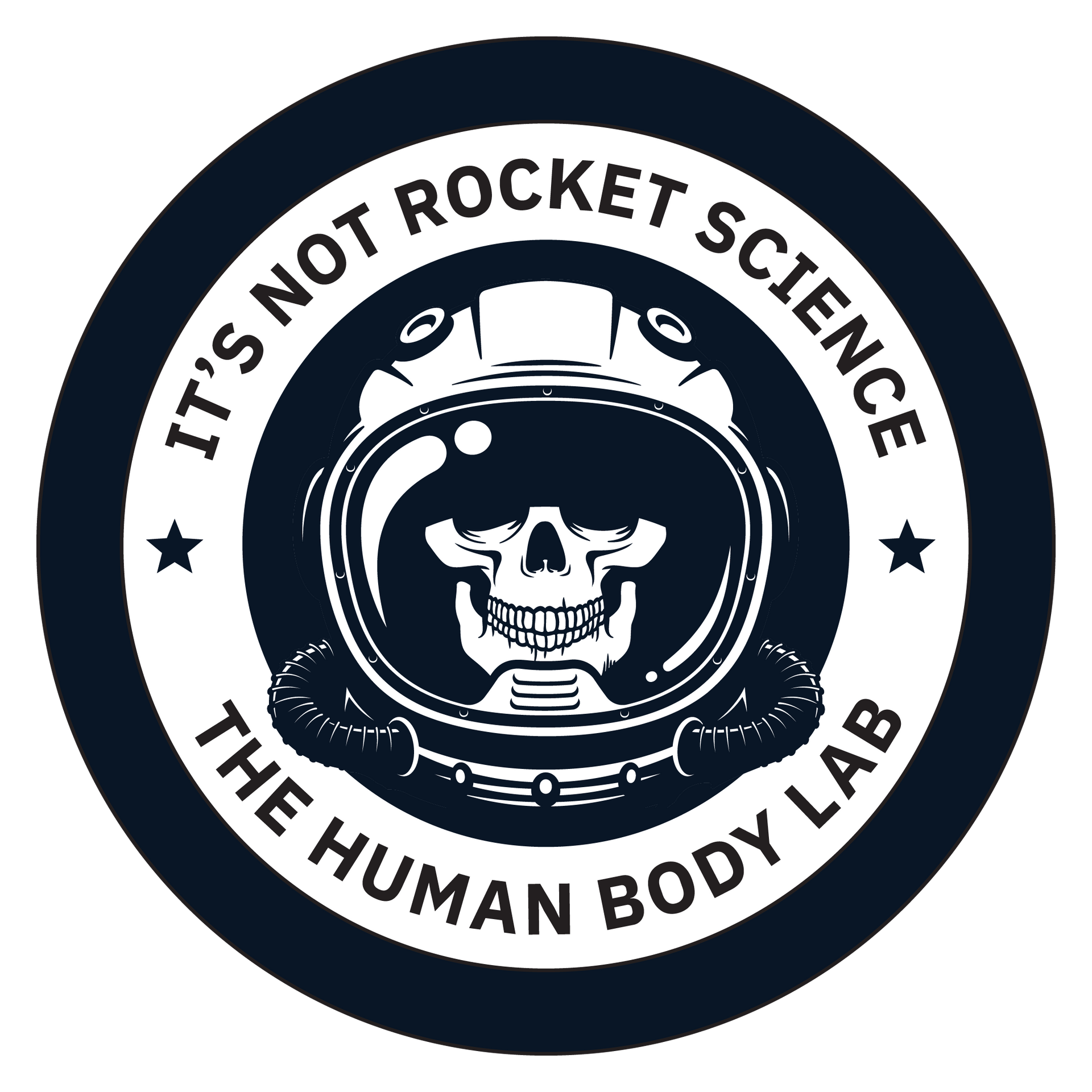Velocity Based Training (VBT)
INTRODUCTION TO VBT
Velocity Based Training (VBT) emerged in the 1990s as a new approach to strength and power training, providing a strategy to increase the sports performance of traditional methods of programming and periodization. This technique utilizes bar speed technology to provide objective data on athletes' performance, allowing for real-time adjustments to any given workout[2]. As bar speed monitoring technology became more accessible and affordable, VBT gained traction in many team weight rooms, offering coaches and athletes a more precise way to calibrate training stressors. As the technology has become more available, individuals can now incorporate the technology into their own programming.
At its core, VBT is not a specific program or routine, but rather an objective methodology for understanding an athlete's performance during strength training exercises[1]. It involves measuring the speed of movement which is usually a barbell. The speed is usually measured in meters per second (m/s), for compound movements such as squats, deadlifts, bench presses, and Olympic lifts[2]. By tracking metrics like average speed, and peak velocity, VBT enables coaches and athletes to individualize training programs based on each athlete's readiness and fatigue levels, ensuring optimal performance and reducing the risk of injuries[3]. This data-driven approach addresses the challenges of traditional planning methods, providing valuable insights that were previously difficult to obtain without sophisticated technology.
The concept of "heavy" is relative in strength training. For one athlete, a 225-pound back squat might be impossible, while for another, it's only a warm-up. This relativity applies not only between different athletes but also to an individual athlete's training sessions over time. Using the 33% rule, approximately one-third of our training days are average, another third are better than average, and the remaining third are below average. Velocity-Based Training (VBT) provides a valuable tool for athletes and coaches to optimize performance. It allows them to capitalize on good days by pushing harder and to adjust accordingly on less optimal days by reducing intensity.
UNDERSTANDING VBT
Velocity-Based Training (VBT) is essentially about measuring the speed at which an athlete moves a weight during exercise. Unlike traditional percentage-based training methods, VBT focuses on the velocity of movement rather than solely on the weight lifted. This approach allows for real-time adjustments to training loads based on an athlete's daily performance capabilities.
At its core, VBT is built on the principle of the load-velocity relationship, which states that there's an inverse correlation between the weight being lifted and the speed at which it can be moved. By monitoring movement velocity, coaches can gain insights into an athlete's current strength levels, fatigue state, and readiness. This information enables more precise control over training intensity and volume, leading to more individualized and effective workout sessions. VBT also incorporates the concept of velocity zones, where specific speed ranges are targeted to achieve different training outcomes such as power development or strength gains[9][12].
BENEFITS OF VBT IN SPORT
The largest strength of VBT is in its ability to adapt training to an athlete's daily physiological state. Unlike standard training protocols that use fixed workout plans, VBT allows for real-time adjustments based on an athlete's current measurements. Some days an athlete might feel incredibly strong, while other days they may need a less intense workout - VBT helps identify and respond to these variations.
Athletic performance is the primary goal of VBT. By tracking velocity, athletes can develop more explosive power and speed, which are critical in many sports. The method provides objective information about an athlete's strength, allowing for more targeted and effective training strategies. Coaches and athletes can now see exactly how an athlete is moving and progressing, rather than relying on subjective assessments.
LIMITATIONS OF VBT
While Velocity-Based Training (VBT) has earned a place in athletic circles, its application for the general population is less beneficial.
EQUIPMENT AND COST BARRIERS
For the general population, the specialized equipment or app subscriptions required for VBT cannot be worth the expense. High-quality velocity measurement devices are often expensive and may not be easy to use in a mainstream gym. This cost factor can make VBT less accessible to the average fitness enthusiast compared to sport focused athletes or well-funded sports teams.
TECHNICAL COMPLEXITY
Information used improperly may do more harm than good. VBT requires a certain level of technical knowledge to implement effectively. While athletes often have access to trained coaches who can interpret the data, the general population may struggle to understand and apply VBT principles correctly[9]. This can lead to misuse or ineffective implementation of the training method.
TIME AND EFFORT INVESTMENT
Setting up VBT equipment and analyzing the data can be time-consuming. For busy individuals in the general population, this additional time investment may not be practical or desirable, especially when compared to more straightforward training methods[8].
RELEVANCE TO FITNESS GOALS
Many individuals in the general population have fitness goals that differ from those of athletes. While VBT excels in developing power and speed, which are crucial for athletic performance, these may not be primary objectives for the average gym-goer focused on general health, weight management, or basic strength gains[9].
PSYCHOLOGICAL FACTORS
The constant feedback and data from VBT devices might be overwhelming or demotivating for some individuals in the general population. Unlike athletes who are accustomed to performance metrics, regular gym-goers might find the continuous measurement stressful or distracting from their workout experience. This is sometimes called “analysis by paralysis”.
OVEREMPHASIS ON SPEED
When used improperly VBT's focus on movement speed might lead to an overemphasis on velocity in movements that velocity is not a primary factor. For the general population, factors like proper form, consistency, and overall workout enjoyment are often more critical than measuring bar speed[10].
HOW TO MEASURE VBT
VBT requires specialized equipment or apps to measure movement velocity accurately. The equipment based systems use Linear Position Transducers (LPTs). These devices are mounted to the floor or rack and a cable to the bar. As the bar moves the cable moves as well. This speed is measure by the equipment. The app systems generally use cameras to measure bar speed.
COMMON TOOLS INCLUDE:
1. Linear Position Transducers
- Popular devices include GymAware, Vitruve encoder, and Enode.
2. Accelerometer-based devices
3. Video analysis software
4. Smartphone apps (e.g., Metric VBT app)
- Popular apps include Metric, TrueRep VBT, and My Jump Lab
REPETITIONS AND SETS
VBT allows for flexible rep schemes. The most common approach is to determine a desired speed and continue performing reps until the velocity drops below a certain threshold (e.g., 10% below the target velocity). This ensures quality reps and accounts for daily fluctuations in performance[3].
EXERCISE SELECTION
VBT is most effective with compound, multi-joint exercises that allow for a full range of motion. Examples include squats, bench presses, deadlifts, and Olympic lifts. These movements provide the most transfer to athletic performance[2][5]. Measuring the speed of a bicep curl has little no real life value.
IMPLEMENTING VBT IN YOUR WORKOUTS
Steps to implement VBT:
1. Choose a velocity zone based on your training goal (e.g., strength, power, speed)[6].
2. Select an initial weight and perform the movement as explosively as possible[6].
3. Adjust the weight based on the measured velocity to match your target velocity zone[6].
4. Continue adjusting until you find the appropriate load for your target velocity[6].
* Target velocities will be discussed later in this article.
SAMPLE VBT WORKOUT
Here's a basic VBT workout structure:
1. Main lift (e.g., Squat): 5 sets of 3 reps at 0.5-0.7 m/s
2. Power movement (e.g., Jump Squat): 3 sets of 5 reps at >1.0 m/s 4.
3. Accessory lift (e.g., Bench Press): 4 sets of 5 reps at 0.4-0.6 m/s
LOAD SELECTION
In VBT, load selection is somewhat of a moving target and based on the desired velocity. Generally individuals start with a moderate weight and adjust based on the measured velocity. If the velocity is too high, increase the weight; if it's too low, decrease it[6].
Recall that Velocity-Based Training (VBT) uses bar speed (measured in meters per second, or m/s) to guide training intensity and ensure athletes are working toward specific performance goals. The chart provided outlines the relationship between bar speed, training goals, and approximate load percentages (% of 1-rep max or 1RM). Here's a breakdown of each training goal and what it means:
1. STARTING STRENGTH
- Bar Speed:> 1.3 m/s
- Load:Very light weights (typically <30% of 1RM)
- Purpose: This phase focuses on developing the ability to initiate movement quickly from a dead stop. It’s often used to improve neuromuscular efficiency and is critical for beginners or athletes recovering from injury. The light load allows for explosive movement without fatiguing the muscles.
2. SPEED-STRENGTH
- Bar Speed:1.0 – 1.3 m/s
- Load:~30–40% of 1RM
- Purpose: Speed-strength emphasizes moving light-to-moderate loads as quickly as possible. This is ideal for athletes who need to generate high power output in sports requiring rapid acceleration (e.g., sprinters, jumpers). The focus is on speed rather than maximum force.
3. STRENGTH-SPEED
- Bar Speed:0.75 – 1.0 m/s
- Load:~40–65% of 1RM
- Purpose: Strength-speed is about producing high force at relatively high velocities. It’s a balance between speed and strength, making it valuable for athletes in power sports like weightlifting, football, or rugby. This zone builds explosive power while still maintaining some velocity.
4. ACCELERATIVE STRENGTH
- Bar Speed: 0.5 – 0.75 m/s
- Load:~65–80% of 1RM
- Purpose: Accelerative strength focuses on moving heavier loads with controlled speed. It bridges the gap between power and maximal strength development, helping athletes improve their ability to lift heavy weights explosively.
5. ABSOLUTE STRENGTH
- Bar Speed: < 0.5 m/s
- Load: ~85–100% of 1RM
- Purpose: Absolute strength is the maximum amount of force an athlete can generate regardless of speed. Training in this range builds raw strength and is essential for powerlifters or anyone aiming to increase their maximum lifts (e.g., squats, deadlifts).
6. 1RM THRESHOLD
- Bar Speed: ~0.3 m/s
- Load:Maximum load (100% of 1RM)
- Purpose: This represents the slowest bar speed at which you can still complete a lift successfully. It’s typically used to test an athlete’s true one-rep max (1RM). Bar speed below this threshold often results in failed lifts.
KEY TAKEAWAYS
- As bar speed decreases, the load increases, shifting the focus from speed and explosiveness to raw strength.
- Each training goal corresponds to specific athletic needs:
- Lighter weights and faster speeds develop power and explosiveness.
- Heavier weights and slower speeds build strength.
- Intermediate zones (speed-strength and strength-speed) combine elements of both.

SOURCES
[1] https://vitruve.fit/blog/velocity-based-training-the-ultimate-guide/
[2] https://en.wikipedia.org/wiki/Velocity_based_training
[3] https://www.outputsports.com/blog/why-use-velocity-based-training
[4] https://www.scienceforsport.com/velocity-based-training/
[5] https://www.outputsports.com/blog/guide-to-velocity-based-training
[6] https://pmc.ncbi.nlm.nih.gov/articles/PMC8156188/
[7] https://gymaware.com/velocity-based-training/
[8] https://www.sportsmith.co/articles/what-is-velocity-based-training/
[9] https://www.frontiersin.org/journals/physiology/articles/10.3389/fphys.2022.926972/full
[10] https://simplifaster.com/articles/velocity-based-training-options-strength/
[11] https://www.sportsmith.co/articles/an-applied-guide-to-velocity-based-training-for-maximal-strength/










